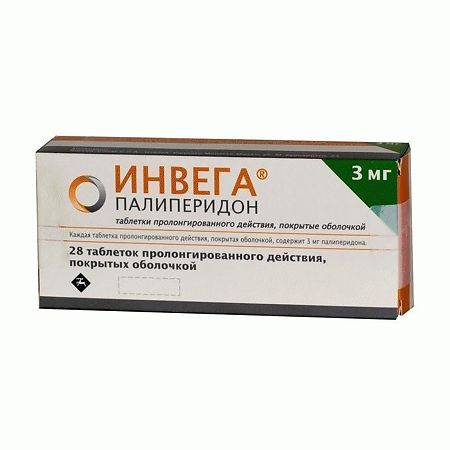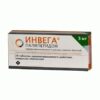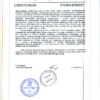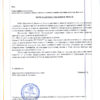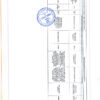No products in the cart.
Invega, 3 mg 28 pcs.
€51.00 €42.50
Out of stock
(E-mail when Stock is available)
Description
Invega is an antipsychotic.
Pharmacodynamics
The mechanism of action
Paliperidone is a centrally acting antagonist of dopamine D2 receptors, which also has high antagonism to serotonin 5-NT2 receptors. In addition, paliperidone is an antagonist of α1– and α2-adrenergic receptors and H1-histamine receptors. Paliperidone has no affinity for cholinergic, muscarinic, and β1– and β2-adrenergic receptors. The pharmacological activity of the (+) and (-)-enantiomers of paliperidone is the same qualitatively and quantitatively.
The antipsychotic action is due to blockade of D2-dopaminergic receptors in the mesolimbic and mesocortical system. Causes less suppression of motor activity and is less likely to induce catalepsy than classical antipsychotics (neuroleptics).
The balanced central antagonism to serotonin and dopamine may reduce the propensity for extrapyramidal side effects and extend the therapeutic effects of the drug to include negative and productive symptoms of schizophrenia.
Paliperidone has effects on sleep patterns: decreases the latent period before falling asleep, decreases the number of awakenings after falling asleep, increases total sleep duration, increases sleep time, and increases the sleep quality index. It has an antiemetic effect, and may cause an increase in plasma prolactin concentrations.
Pharmacokinetics
Unless otherwise stated, the pharmacokinetic data presented in this section are based on data obtained for adult patients. The pharmacokinetic characteristics of paliperidone after oral administration are proportional to the dose taken in the recommended therapeutic range (3-12 mg once daily).
Absorption
After a single dose of the drug, plasma concentrations of paliperidone increased steadily, and Cmax was reached after 24 h. In most patients, equilibrium concentrations of paliperidone were reached after 4-5 days of taking the drug once daily. Paliperidone is the active metabolite of risperidone. Peculiarities of the active substance release from the drug Invega® ensured less fluctuations of maximum and minimum concentrations of paliperidone than those observed with conventional dosage forms (concentration fluctuation index – 38% compared to 125% for conventional dosage forms).
The (+) and (-) enantiomers are mutually converted after taking paliperidone tablets, and the AUC – AUC (+)/AUC (-) ratio at equilibrium is approximately 1.6. The absolute bioavailability of paliperidone after oral administration is 28% (23-33% at 90% confidence interval). After a single dose of 15 mg of paliperidone as a sustained-release tablet together with a high-fat, high-calorie diet, Cmax and AUC increased by an average of 42 and 46% respectively relative to the same values when taking the tablet on an empty stomach. In another study, after a single administration of 12 mg of paliperidone as a sustained-release tablet together with a fatty, high-calorie food, Cmax and AUC increased by an average of 60 and 54%, respectively, relative to those same values when the tablet was taken on an empty stomach. Thus, the presence or absence of food in the stomach during paliperidone administration may alter the plasma concentration of paliperidone.
Distribution
Paliperidone is rapidly distributed in tissues and body fluids. The apparent Vd is 487 l. The degree of binding to plasma proteins is 74%. Paliperidone binds predominantly to α1-acid glycoprotein and albumin.
Biotransformation and elimination
1 week after taking one standard tablet containing 1 mg of paliperidone, 59% of the dose was excreted unchanged in the urine; this indicates that paliperidone is not extensively metabolized in the liver. About 80% of the drug was detected in the urine and about 11% in the feces. Four pathways of paliperidone metabolism in vivo are known, none of which covers more than 6.5% of the dose: dealkylation, hydroxylation, dehydrogenation and benzisoxazole cleavage. In vitro studies have shown that the cytochrome P450 isoenzymes CYP2D6 and CYP3A4 may play a role in paliperidone metabolism, but evidence that they play a significant role in paliperidone metabolism in vivo was not available. Although CYP2D6 isoenzyme activity varies significantly in the general population, population pharmacokinetic studies have found no significant differences in apparent clearance of paliperidone in patients with active CYP2D6 isoenzyme substrate metabolism and in patients with poor CYP2D6 isoenzyme substrate metabolism. In vitro studies using heterologous microsomal preparations showed that CYP1A2, CYP2A6, CYP2C9,CYP2C19 and CYP3A5 isoenzymes are not involved in paliperidone metabolism.
The final T1/2 of paliperidone is approximately 23 h.
In vitro studies have shown that paliperidone is a substrate of P-glycoprotein and in high concentrations weakly inhibits it. There are no in vivo data and the clinical relevance is unknown.
Particular groups
Patients with impaired liver function. Paliperidone is not extensively metabolized in the liver. In patients with mild to moderate hepatic impairment there is no need to reduce the dose of paliperidone. A study involving patients with moderate hepatic impairment (class B according to Child-Pugh classification) has shown that in these patients plasma concentrations of unbound paliperidone were similar to those in healthy subjects. The use of Invega® in patients with severe hepatic impairment has not been studied.
Patients with impaired renal function. The dose of paliperidone should be reduced in patients with moderate to severe renal dysfunction. Paliperidone excretion has been studied in patients with varying degrees of renal dysfunction. It was found that paliperidone elimination decreased as creatinine clearance decreased. Total paliperidone clearance was reduced by 32% in patients with mild renal impairment (creatinine Cl 50 to1/2 of paliperidone was 24, 40 and 51 h in patients with mild, moderate and severe renal impairment, respectively; in those with normal renal function (creatinine Cl >80 ml/min) the figure was 23 h.
Adolescents. The systemic effects of paliperidone in adolescents were comparable to those in adults. Plasma concentrations of paliperidone in adolescents with body weight
Elderly patients. It is not recommended to change the dose of paliperidone depending on the patient’s age. The results of a pharmacokinetic study involving elderly patients aged 65 years and older showed that the apparent clearance of paliperidone at equilibrium after administration of Invega® in this group was 20% lower than in adult patients aged 18-45 years. However, after adjusting for age-related decreases in creatinine clearance, population-based analyses showed no effect of age of schizophrenic patients on paliperidone pharmacokinetics.
Raciality. No dose modification is required for patients of different racial backgrounds. Population pharmacokinetic analysis showed no racial differences in paliperidone pharmacokinetics with Invega®. No differences in pharmacokinetics were found in studies of Japanese and Caucasians.
Paul. The recommended doses of paliperidone are the same for men and women. The apparent clearance of paliperidone after taking the drug is about 19% lower in women than in men. This difference is mainly due to differences in the fat-free component of body weight and creatinine clearance between men and women, since population-based studies, after adjusting for the fat-free component of body weight and creatinine clearance, have found no clinically significant differences in the pharmacokinetics of paliperidone in men and women taking the drug.
Smoking. It is not recommended to modify doses of paliperidone in smokers. In vitro studies using human liver enzymes have shown that paliperidone is not a substrate of CYP1A2 isoenzyme and therefore smoking should not affect the pharmacokinetics of paliperidone. Consistent with in vitro studies, population-based studies showed no differences in paliperidone pharmacokinetics between smokers and nonsmokers.
Indications
Indications
schizophrenia, incl. in the acute phase in adult patients;
prevention of exacerbations of schizophrenia in adults;
treatment of schizophrenia in adolescents aged 12 to 17 years;
treatment of schizoaffective disorders: as monotherapy or as part of combination therapy with antidepressants and/or mood stabilizers in adult patients.
Pharmacological effect
Pharmacological effect
Invega is an antipsychotic.
Pharmacodynamics
Mechanism of action
Paliperidone is a centrally acting dopamine D2 receptor antagonist that also has potent antagonism at serotonin 5-HT2 receptors. In addition, paliperidone is an antagonist of α1- and α2-adrenergic receptors and H1-histamine receptors. Paliperidone does not have affinity for cholinergic, muscarinic, or β1- and β2-adrenergic receptors. The pharmacological activity of the (+) and (−) enantiomers of paliperidone is the same in qualitative and quantitative terms.
The antipsychotic effect is due to the blockade of D2-dopaminergic receptors of the mesolimbic and mesocortical systems. Causes less suppression of motor activity and induces catalepsy to a lesser extent than classical antipsychotics (neuroleptics).
Balanced central antagonism of serotonin and dopamine may reduce the propensity for extrapyramidal side effects and expand the therapeutic effect of the drug to cover negative and productive symptoms of schizophrenia.
Paliperidone has an effect on sleep structure: it reduces the latency period before falling asleep, reduces the number of awakenings after falling asleep, increases the total duration of sleep, increases sleep time and increases the sleep quality index. It has an antiemetic effect and may cause an increase in the concentration of prolactin in the blood plasma.
Pharmacokinetics
Unless otherwise stated, pharmacokinetic data presented in this section are based on data obtained in adult patients. The pharmacokinetic characteristics of paliperidone after oral administration are proportional to the dose taken within the recommended therapeutic range (3–12 mg once daily).
Absorption
After taking one dose of the drug, the concentration of paliperidone in plasma steadily increased, and Cmax was reached after 24 hours. In most patients, equilibrium concentrations of paliperidone were achieved after 4-5 days of taking the drug once a day. Paliperidone is an active metabolite of risperidone. The release characteristics of the active substance from Invega® ensured smaller fluctuations in the maximum and minimum concentrations of paliperidone than those observed when using conventional dosage forms (concentration fluctuation index – 38% compared to 125% for conventional dosage forms).
After taking paliperidone tablets, the (+) and (−) enantiomers are interconverted, and the AUC ratio – AUC (+)/AUC (−) – at steady state is approximately 1.6. The absolute bioavailability of paliperidone after oral administration is 28% (23–33%, 90% confidence interval). Following a single dose of 15 mg paliperidone extended-release tablet with a high-fat, high-calorie meal, Cmax and AUC increased by an average of 42 and 46%, respectively, relative to the same values when taking the tablet on an empty stomach. In another study, following a single dose of 12 mg paliperidone extended-release tablet with a high-fat, high-calorie meal, Cmax and AUC increased by an average of 60% and 54%, respectively, relative to those when the tablet was administered on an empty stomach. Therefore, the presence or absence of food in the stomach while taking paliperidone may alter the plasma concentration of paliperidone.
Distribution
Paliperidone is rapidly distributed in tissues and body fluids. Apparent Vd – 487 l. The degree of binding to plasma proteins is 74%. Paliperidone binds predominantly to α1-acid glycoprotein and albumin.
Biotransformation and elimination
1 week after taking one standard tablet containing 1 mg of paliperidone, 59% of the dose was excreted unchanged in the urine; this indicates that paliperidone is not extensively metabolized in the liver. About 80% of the drug was found in urine and about 11% in feces. There are four known pathways for paliperidone metabolism in vivo, none of which account for more than 6.5% of the dose: dealkylation, hydroxylation, dehydrogenation and benzisoxazole degradation. In vitro studies have shown that cytochrome P450 isoenzymes CYP2D6 and CYP3A4 may play a role in the metabolism of paliperidone, but evidence that they play a significant role in the metabolism of paliperidone in vivo has not been obtained. Although CYP2D6 activity varies significantly in the general population, population pharmacokinetic studies have not revealed significant differences in the apparent clearance of paliperidone in patients with extensive metabolism of CYP2D6 substrates and in patients with poor metabolism of CYP2D6 substrates. In vitro studies using microsomal preparations of heterologous systems showed that the isoenzymes CYP1A2, CYP2A6, CYP2C9, CYP2C19 and CYP3A5 are not involved in the metabolism of paliperidone.
The final half-life of paliperidone is about 23 hours.
In vitro studies have shown that paliperidone is a substrate of P-glycoprotein and weakly inhibits it at high concentrations. No in vivo data available, clinical significance unknown.
Special groups
Patients with impaired liver function. Paliperidone is not extensively metabolized in the liver. In patients with mild to moderate hepatic impairment, there is no need to reduce the dose of paliperidone. A study in patients with moderate hepatic impairment (Child-Pugh class B) showed that these patients had plasma concentrations of unbound paliperidone similar to those in healthy subjects. The use of Invega® in patients with severe liver dysfunction has not been studied.
Patients with impaired renal function. The dose of paliperidone should be reduced in patients with moderate to severe renal impairment. The excretion of paliperidone was studied in patients with varying degrees of renal impairment. It was found that the elimination of paliperidone decreased as creatinine clearance decreased. The overall clearance of paliperidone was reduced by 32% in patients with mild renal impairment (creatinine clearance from 50 to 1/2 paliperidone was 24, 40 and 51 hours in patients with mild, moderate and severe renal impairment, respectively; in people with normal renal function (creatinine clearance >80 ml/min) this figure was 23 hours.
Teenagers. Systemic exposure to paliperidone in adolescents was comparable to that in adults. Plasma concentrations of paliperidone in overweight adolescents
Elderly patients. It is not recommended to change the dose of paliperidone depending on the patient’s age. The results of a pharmacokinetic study in elderly patients aged 65 years and older showed that the apparent clearance of paliperidone at steady state after taking Invega in this group was 20% lower than in adult patients aged 18-45 years. However, after adjusting for the age-related decrease in creatinine clearance, population analysis did not reveal the effect of the age of patients with schizophrenia on the pharmacokinetics of paliperidone.
Race. No dose adjustments are required for patients of different races. Population pharmacokinetic analysis showed no racial differences in the pharmacokinetics of paliperidone when using Invega®. No differences in pharmacokinetics were found in studies of Japanese and Caucasians.
Floor. Recommended doses of paliperidone are the same for men and women. The apparent clearance of paliperidone after taking the drug in women is approximately 19% lower than in men. This difference is primarily due to differences in lean body mass and creatinine clearance between men and women, as population-based studies, after adjustment for lean body mass and creatinine clearance, did not reveal clinically significant differences in the pharmacokinetics of paliperidone between men and women taking the drug.
Smoking. It is not recommended to change the dose of paliperidone in smokers. In vitro studies using human liver enzymes have shown that paliperidone is not a CYP1A2 substrate and therefore smoking should not affect the pharmacokinetics of paliperidone. Consistent with the results of in vitro studies, population studies did not reveal differences in the pharmacokinetics of paliperidone between smokers and non-smokers.
Special instructions
Special instructions
ZNS. It is known that antipsychotic drugs, including paliperidone, can cause NMS, which is characterized by hyperthermia, muscle rigidity, instability of the autonomic nervous system, depression of consciousness, and increased serum concentrations of CPK. Myoglobinuria (rhabdomyolysis) and acute renal failure may also occur in patients with NMS. If a patient experiences objective or subjective symptoms of NMS, all antipsychotic medications, including paliperidone, should be immediately discontinued.
Tardive dyskinesia. Drugs with dopamine receptor antagonist properties can cause tardive dyskinesia, which is characterized by rhythmic involuntary movements, mainly of the tongue and/or facial muscles. If a patient experiences objective or subjective symptoms indicating tardive dyskinesia, the advisability of discontinuing all antipsychotic drugs, including paliperidone, should be considered.
Prolongation of the QT interval. As with other antipsychotics, caution should be exercised when prescribing Invega® to patients with a history of cardiac arrhythmias, congenital prolongation of the QT interval, and concomitant use with drugs that prolong the QT interval.
Hyperglycemia and diabetes mellitus. Hyperglycemia, diabetes mellitus and exacerbation of existing diabetes mellitus were observed during treatment with Invega®. Establishing a relationship between the use of atypical antipsychotic drugs and disorders of glucose metabolism is complicated by the increased risk of developing diabetes mellitus in patients with schizophrenia and the prevalence of diabetes mellitus in the general population. Given these factors, the relationship between the use of atypical antipsychotic drugs and the development of adverse effects associated with hyperglycemia is not fully established. In patients diagnosed with diabetes mellitus, glucose levels should be regularly monitored. Patients with risk factors for diabetes mellitus (eg, obesity, family history of diabetes) should have fasting blood glucose levels monitored at the start of treatment and periodically during treatment. All patients should be clinically monitored for symptoms of hyperglycemia and diabetes mellitus. Patients who develop symptoms of hyperglycemia while being treated with atypical antipsychotics should have their blood glucose levels monitored. In some cases, symptoms of hyperglycemia have resolved with discontinuation of atypical antipsychotic medications, but some patients require antidiabetic treatment despite discontinuation of the drug.
Increase in body weight. Significant weight gain was observed during treatment with atypical antipsychotics. It is necessary to monitor patients’ body weight.
Hyperprolactinemia. Like other D2-dopamine receptor antagonists, paliperidone increases prolactin levels, and this increase persists throughout drug use. The effects of paliperidone are comparable to those of risperidone, the drug that has the greatest effect on prolactin levels among other antipsychotic drugs. Hyperprolactinemia, regardless of etiology, can suppress the expression of GnRH in the hypothalamus, which leads to a decrease in the secretion of gonadotropins by the pituitary gland. This in turn can suppress reproductive function, weakening sexual steroidogenesis in women and men. Galactorrhea, amenorrhea, gynecomastia and impotence have been reported in patients taking drugs that increase prolactin levels. Long-term hyperprolactinemia associated with hypogonadism can lead to decreased bone density in women and men.
In vitro tissue culture studies have shown that approximately one third of human breast cancers are prolactin-dependent. This should be taken into account when prescribing drugs that increase prolactin levels to patients with previously diagnosed breast cancer. Clinical and epidemiological studies conducted to date have shown no association between atypical antipsychotic drugs and tumor formation in humans. However, the available data are too limited to draw definitive conclusions.
Orthostatic hypotension. Paliperidone has α-blocking activity and may therefore cause orthostatic hypotension in some patients. Paliperidone should be used with caution in patients with cardiovascular disease (for example, heart failure, myocardial infarction or ischemia, cardiac conduction disorders), cerebrovascular disease, and with conditions that contribute to arterial hypotension (for example, dehydration, hypovolemia and therapy with antihypertensive drugs).
Regulation of body temperature. Antipsychotic drugs are associated with such undesirable effects as disruption of the body’s ability to regulate temperature. Caution should be exercised when prescribing paliperidone to patients with conditions that may contribute to an increase in core body temperature, including intense exercise, dehydration, exposure to high external temperatures, or concomitant use of drugs with anticholinergic activity.
Antiemetic effect. Preclinical studies have demonstrated the antiemetic effect of paliperidone. This effect, when observed in humans, may mask objective and subjective symptoms of overdose of some drugs, as well as diseases such as intestinal obstruction, Reye’s syndrome, and brain tumors.
Priapism. Drugs with α-adrenergic blocking effects can cause priapism. Priapism has been reported in post-marketing studies of paliperidone.
Suicidal attempts. The possibility of suicide attempts is characteristic of mental illness, so treatment of patients at high risk should be carried out under close supervision. In these cases, Invega® should be prescribed in a minimum number of tablets to reduce the risk of overdose.
Leukopenia, neutropenia, agranulocytosis. Leukopenia, neutropenia and agranulocytosis were observed with the use of antipsychotics, incl. when using the drug Invega®. Agranulocytosis has been observed very rarely during post-marketing surveillance. In patients with a history of clinically significant decreases in white blood cell count or drug-dependent leukopenia/neutropenia, a complete blood count is recommended during the first months of therapy; Discontinuation of treatment with Invega should be considered at the first clinically significant decrease in the white blood cell count in the absence of other possible causes. Patients with clinically significant neutropenia are advised to be monitored for fever or symptoms of infection and to initiate treatment immediately if such symptoms occur. Patients with severe neutropenia (absolute neutrophil count less than 1·109/l) should stop using Invega® until the white blood cell count returns to normal.
Venous thromboembolism. Cases of venous thromboembolism have been reported with the use of antipsychotic drugs. Since patients taking antipsychotic drugs are often at risk of developing venous thromboembolism, all possible risk factors should be identified before and during treatment with Invega® and preventive measures taken.
Intraoperative floppy iris syndrome (ISID). ISDR was observed during surgery for the presence of cataracts in patients receiving therapy with drugs of the α1-adrenergic receptor antagonist group. ISDR increases the risk of complications associated with the organ of vision during and after surgery. The doctor performing such an operation should be informed in advance that the patient has taken or is currently taking drugs that have α1-adrenergic receptor antagonist activity. The potential benefit of discontinuing α1-adrenergic antagonist therapy before surgery has not been established and should be weighed against the risks associated with discontinuing antipsychotic therapy.
Pregnancy and child care. The patient should notify his or her physician of pregnancy or planning to become pregnant during treatment with Invega®. Caution should be exercised when prescribing Invega® to nursing mothers (see “Use during pregnancy and lactation”).
Drinking alcohol. Patients should avoid drinking alcohol during treatment with Invega®.
Conditions leading to a decrease in the presence of the drug in the gastrointestinal tract. Conditions that reduce the presence of the drug in the gastrointestinal tract, such as diseases associated with chronic diarrhea, may cause a decrease in the absorption of paliperidone.
Invega® tablets are manufactured using osmotic release technology, in which osmotic pressure releases paliperidone at a controlled rate. The system, which looks like a capsule-shaped tablet, consists of an osmotically active three-layer core surrounded by an intermediate shell and a semi-permeable membrane. The three-layer core consists of two medicinal layers containing the drug substance and excipients, as well as an ejector layer containing osmotically active components. On the dome side of the drug layers there are two outlet holes made using a laser. In the gastrointestinal tract, the colored shell quickly dissolves, and water begins to flow into the tablet through a semi-permeable control membrane. The membrane controls the level of water intake, and this in turn controls the level of drug release.
The hydrophilic polymers in the tablet core absorb water and swell into a gel containing paliperidone, which is then expelled through holes in the dome. The insoluble components of the tablet are excreted from the body in the stool. Patients should not worry if they notice something that looks like a pill in their stool.
Influence on driving a car and working with machinery. Paliperidone may interfere with activities requiring rapid mental response and may also have visual effects, so patients should avoid driving or operating machinery until their individual sensitivity to paliperidone has been established.
Active ingredient
Active ingredient
Paliperidone
Composition
Composition
Active ingredient:
paliperidone 3 mg;
Excipients:
macrogol 200K;
macrogol 7000K;
sodium chloride;
povidone (K29-32);
hyethylosis;
stearic acid;
butylated hydroxytoluene;
iron oxide red;
iron oxide yellow;
macrogol 3350;
cellulose acetate (398-10);
dark yellow dye (hypromellose, titanium dioxide, polyethylene glycol 400, yellow iron oxide);
carnauba wax
Contraindications
Contraindications
Contraindicated in patients with hypersensitivity to paliperidone, risperidone, or any auxiliary ingredient of the drug.
With caution: a history of convulsive conditions and diseases that reduce the threshold of convulsive readiness. As with other antipsychotics, paliperidone should be used with caution in patients with a history of seizures or other conditions that lower the seizure threshold.
Dysphagia and narrowing of the gastrointestinal tract (possibility of obstruction). Invega® tablets do not deform and hardly change their shape in the gastrointestinal tract, and therefore they should not be prescribed to patients with severe narrowing of the gastrointestinal lumen (pathological or iatrogenic), as well as to patients who suffer from dysphagia or who have difficulty swallowing tablets. There are rare reports of symptoms of gastrointestinal obstruction associated with the ingestion of non-deformable dosage forms with controlled release of the active substance. Paliperidone also belongs to such dosage forms, and therefore it can only be prescribed to those patients who can swallow tablets whole.
Elderly patients with dementia. The efficacy and safety of paliperidone have not been evaluated in elderly patients with dementia. A meta-analysis of 17 placebo-controlled studies found that elderly patients with dementia treated with atypical antipsychotic drugs such as risperidone, aripiprazole, olanzapine, and quetiapine had a higher mortality rate compared with patients treated with placebo. Placebo-controlled studies in elderly patients with dementia have demonstrated an increased incidence of cerebrovascular adverse events (stroke and transient ischemic attack), incl. fatalities in patients receiving certain atypical antipsychotics, including risperidone, aripiprazole and olanzapine, compared with patients receiving placebo.
Parkinson’s disease and dementia with Lewy bodies. Clinicians should carefully weigh the risks and potential benefits when prescribing antipsychotic drugs, including paliperidone, to patients with Parkinson’s disease or dementia with Lewy bodies, as these patients may be at increased risk of developing neuroleptic malignant syndrome (NMS) or have increased sensitivity to antipsychotic drugs. Manifestations of this increased sensitivity include, in addition to extrapyramidal symptoms, confusion, dullness of reactions and postural hypotension with frequent falls.
Side Effects
Side Effects
Infections: often – upper respiratory tract infections, nasopharyngitis; uncommon – urinary tract infections, acrodermatitis, bronchitis, inflammation of subcutaneous fat, cystitis, ear infections, influenza, onychomycosis, pneumonia, respiratory tract infections, sinusitis, tonsillitis.
From the immune system: infrequently – anaphylactic reaction, hypersensitivity.
From the hematopoietic and lymphatic system: infrequently – anemia, decreased hematocrit, neutropenia, decreased white blood cell count; rarely – thrombocytopenia; very rarely – agranulocytosis.
From the endocrine system: infrequently – hyperprolactinemia; very rarely – inadequate secretion of ADH.
From the side of metabolism and nutrition: infrequently – increased CPK activity, anorexia, hyperglycemia; rarely – diabetes mellitus, hypoglycemia, water intoxication; very rarely – diabetic ketoacidosis.
Mental disorders: often – insomnia (including initial and moderate insomnia), mania; infrequently – nightmares, sleep disturbances, depression.
From the nervous system: very often – headache; often – akathisia, dystonia, dysarthria, increased muscle tone, parkinsonism, sedation, drowsiness, tremor, drooling; uncommon – cerebrovascular disorders, postural dizziness, dyskinesia, convulsions, fainting, impaired attention, hypoesthesia, loss of consciousness, paresthesia, psychomotor hyperactivity, tardive dyskinesia, hypokinesia, opisthotonus.
It is known that antipsychotic drugs, including paliperidone, can cause NMS, which is characterized by hyperthermia, muscle rigidity, instability of the autonomic nervous system, depression of consciousness, increased CPK activity, myoglobinuria, rhabdomyolysis, and acute renal failure.
From the organs of vision: infrequently – conjunctivitis, dry eyes, photophobia, lacrimation; with unknown frequency – floppy iris syndrome (intraoperative).
From the organ of hearing and labyrinthine disorders: infrequently – ear pain, vertigo, ringing in the ears.
From the cardiovascular system: infrequently – bradycardia, palpitations, AV block, conduction disturbances, ECG changes, increased QT interval, ischemia, flushing, increased blood pressure, decreased blood pressure; rarely – atrial fibrillation; very rarely – deep vein thrombosis, pulmonary embolism.
From the gastrointestinal tract: often – nausea, diarrhea, constipation, discomfort in the upper abdomen, dyspepsia, increased appetite; uncommon – decreased appetite, inflammation of the lip, dysphagia, fecal incontinence, small intestinal obstruction, flatulence, gastroenteritis, swelling of the tongue, toothache, dysgeusia; very rarely – pancreatitis, intestinal obstruction.
From the liver and biliary tract: very rarely – jaundice.
From the respiratory system: infrequently – pain in the pharyngolaryngeal region, nasal congestion, cough, shortness of breath, hyperventilation, wheezing; rarely – sleep apnea syndrome.
From the musculoskeletal and connective tissue side: often – myalgia, musculoskeletal pain; Uncommon: muscle spasms, back pain, arthralgia, joint stiffness, joint swelling, muscle weakness, neck pain.
From the skin and subcutaneous tissues: uncommon – rash, itching, acne, dry skin, eczema, erythema, seborrheic dermatitis, skin discoloration; rarely – Quincke’s edema, alopecia.
From the kidneys and urinary tract: infrequently – dysuria, pollakiuria, urinary incontinence, urinary retention.
From the genital organs and mammary gland: infrequently – decreased libido, anorgasmia, nipple discharge, erectile dysfunction, gynecomastia, changes in the menstrual cycle, sexual dysfunction, vaginal discharge, impaired ejaculation, engorgement of the mammary glands; very rarely – priapism.
Effect on the course of pregnancy, postpartum and perinatal conditions: very rarely – withdrawal syndrome in newborns.
Others: often – weight gain; uncommon – weight loss, chills, facial swelling, gait disturbance, edema (including generalized, peripheral, mild), increased body temperature, fever, thirst; very rarely – hypothermia.
Laboratory tests: uncommon – increased GGT activity, increased liver enzyme activity, increased transaminase activity, increased blood cholesterol concentration, increased blood triglyceride concentration.
Overdose
Overdose
Symptoms: in general, objective and subjective symptoms of paliperidone overdose represent enhanced pharmacological effects of this drug, i.e. drowsiness and sedation, tachycardia and hypotension, prolongation of the QT interval and extrapyramidal symptoms. Bidirectional tachycardia and ventricular fibrillation have been observed with overdose of oral paliperidone. In case of acute overdose, it is necessary to consider the possibility of toxic effects of several drugs.
When assessing the therapeutic needs of the patient and the effectiveness of overdose relief, it must be remembered that Invega® is a drug with a prolonged release of the active substance.
Treatment: generally accepted supportive measures should be implemented. A good airway, as well as adequate oxygenation and ventilation, should be established and maintained. It is necessary to immediately organize monitoring of cardiovascular activity (ECG monitoring to identify possible arrhythmias).
Arterial hypotension and collaptoid conditions are treated with intravenous administration of plasma-substituting solutions and/or sympathomimetic agents. In certain situations, gastric lavage is indicated (after intubation, if the patient is unconscious), administration of activated charcoal and laxatives.
If severe extrapyramidal symptoms occur, m-anticholinergic blockers must be administered. Monitoring the patient’s condition and monitoring basic physiological functions must be continued until the effects of the overdose are completely eliminated. There is no specific antidote for paliperidone.
Storage conditions
Storage conditions
At 15–30 °C
Shelf life
Shelf life
2 years
Manufacturer
Manufacturer
Janssen Pharmaceuticals N.V., Belgium
Additional information
| Shelf life | 2 years |
|---|---|
| Conditions of storage | At 15-30 °C |
| Manufacturer | Janssen Pharmaceuticals N.V., Belgium |
| Medication form | slow-release tablets |
| Brand | Janssen Pharmaceuticals N.V. |
Related products
Buy Invega, 3 mg 28 pcs. with delivery to USA, UK, Europe and over 120 other countries.

